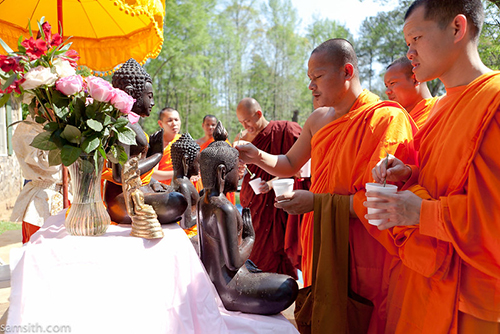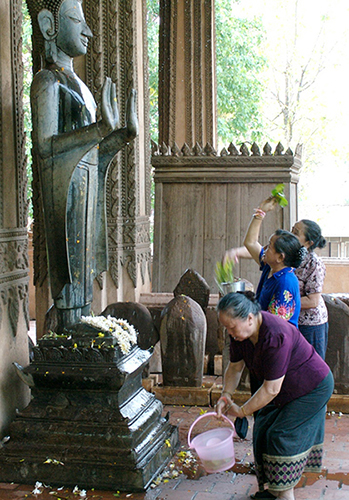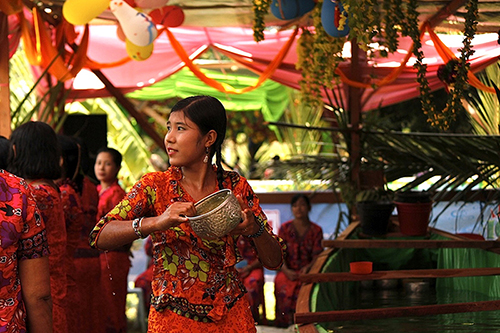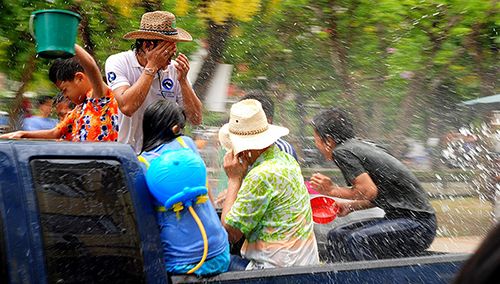The New Year happens in April for a number of southeast Asian countries like Thailand, Cambodia, Myanmar (formerly Burma) and Laos. The celebrations are usually commemorated between April 13 - 16, though sometimes the festivities can last up to a week.
Cambodia
Friday, April 14 - Sunday, April 16, 2023
In Cambodia, the new year is known as Choul Chnam Thmey, translated to English as, Enter the New Year or Moha Sangkranta in Sanskrit which means to move or change. It is celebrated over three days starting from the 13th or 14th of April, which coincides with the end of the harvesting season when farmers enjoy the fruits of their labor before the rainy season begins. Khmer New Year is a precious time for Cambodian people to gather with family, friends, and their community. It is celebrated throughout Cambodia and is rooted in Buddhist traditions.
 Khmer New Year is celebrated for three days, each day is marked by a special ceremony.
Khmer New Year is celebrated for three days, each day is marked by a special ceremony.
- Day one – Maha Sangkran: On this day, the old year ends and a new one begins, and offerings are made to the angels who will come for nourishment and give back blessings for the year.
- Day two – Virak Vanabat: The second day is dedicated to charity and giving back to those in need.
- Day three – Vearak Loeng Sak: This day is dedicated to asking for forgiveness from Buddha for any sins committed.
Image Description: On day three of the Khmer New Year, a ceremony called “Pithi Srang Preah”, is performed, which means giving a special bath or a special shower to Buddha statues and ask for forgiveness from any mistakes made.
Source: Khmer New Year 2011 - Atlanta Buddhist Temple, by Sam Smith.
Lao
Friday, April 14 - Sunday, April 16, 2023
 The Lao people celebrate their New Year, Pi Mai (pronounced Pii-My) every year from April 13 or 14 to April 15 or 16. The celebration is considered to be the most important and biggest traditional festival in the country. The festival coincides with the end of the dry season and the start of the monsoon season. It is seen as a day of rebirth and purification.
The Lao people celebrate their New Year, Pi Mai (pronounced Pii-My) every year from April 13 or 14 to April 15 or 16. The celebration is considered to be the most important and biggest traditional festival in the country. The festival coincides with the end of the dry season and the start of the monsoon season. It is seen as a day of rebirth and purification.
In greetings there are several ways to wish someone a happy Lao New Year. The most common expressions are sôk di pi mai, souksan van pi mai or sabaidi pi mai, which can be translated into English as "Happy New Year."
Image Description: Lao people bathing the Buddha during the new year.
Source: Lao New Year, Buddha bathing, by Sam Haldane.
Myanmar
Thursday, April 13 - Sunday, April 16, 2023
 In Myanmar (formerly Burma), the new year is referred to by the Myanmar people as Thingyan from Sanskrit which means "transit of the Sun from Pisces to Aries". Thingyan has been celebrated since the semi legendary Taguang period (1st-2nd century AD) of Myanmar and became widespread during the Bagan period (10-12th century AD).
In Myanmar (formerly Burma), the new year is referred to by the Myanmar people as Thingyan from Sanskrit which means "transit of the Sun from Pisces to Aries". Thingyan has been celebrated since the semi legendary Taguang period (1st-2nd century AD) of Myanmar and became widespread during the Bagan period (10-12th century AD).
The dates of the festival are observed as public holidays throughout Myanmar and are part of the summer holidays at the end of the school year. Water-throwing or dousing one another from any shape or form of vessel or device that delivers water is the distinguishing feature of this festival and may be done on the first four days of the festival.
Image Description: An Arakan (Rakhine) girl pours water at revellers during the Burmese New Year Thingyan Water Festival in Yangon.
Source: Rakhine Thingyan 2011 by Htoo Tay Zar.
Thailand
Thursday, April 13 - Saturday, April 15, 2023
In Thailand, the new year is called Songkran. The holiday’s main focus is about moving forward—in fact, the word Songkran comes from a phrase in the Sanskrit language that means “passage of the sun.”
 Water plays a major role in the festival. The Thai New Year marks the end of the dry season and is celebrated with splashing water and putting powder on each other's faces as a symbolic sign of cleansing and washing away the sins from the old year. Water is also a symbol of purification. In the more traditional celebrations, young people pour water over the wrists of elders as a show of devotion and gratitude. Most people make time to visit temples, and nearly everyone pours goblets of water with floating orchids and marigolds over Buddha images in a cleansing ritual, hoping for a fresh start in the new year.
Water plays a major role in the festival. The Thai New Year marks the end of the dry season and is celebrated with splashing water and putting powder on each other's faces as a symbolic sign of cleansing and washing away the sins from the old year. Water is also a symbol of purification. In the more traditional celebrations, young people pour water over the wrists of elders as a show of devotion and gratitude. Most people make time to visit temples, and nearly everyone pours goblets of water with floating orchids and marigolds over Buddha images in a cleansing ritual, hoping for a fresh start in the new year.
Image Description: People on the back of a truck get soaked during the Songkran festival in Chiang Mai, Thailand.
Source: Songkran by Takeway.
